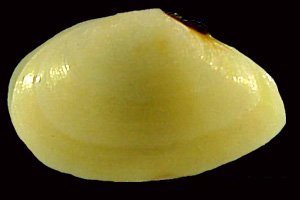Ribbed Tell Clam
| Ribbed Tell Clam | ||||||||||||
|---|---|---|---|---|---|---|---|---|---|---|---|---|

Ribbed Tell Clam ( Fabulina fabula ), aspect from the left |
||||||||||||
| Systematics | ||||||||||||
|
||||||||||||
| Scientific name | ||||||||||||
| Fabulina fabula | ||||||||||||
| Gmelin , 1791 |
The Rib tellin ( Fabulina fabula ) is a bivalve mollusc of the family of tellins (Tellinidae), also in the North Sea is native.
features
The slightly unevenly hinged, strongly flattened housing is up to 20 millimeters long. The right flap is slightly more arched than the left flap. The housing is elongated-ovoid to wedge-shaped in outline. The vertebrae sit a little behind the midline. They are turned inwards and a little forwards and almost touch each other. The flat arched anterior dorsal margin is shorter than the posterior dorsal margin, and slopes down to the broadly rounded anterior end. The posterior, longer dorsal margin is almost straight and sloping more steeply. It goes over with a very flat kink in the flat rounded rear edge. The posterior margin merges into the ventral margin in a tightly rounded manner. This is where a flat back ends from the vertebra. The ventral edge is almost straight from the transition to the rear edge to about the midline, then well rounded to the front edge. The rear part of the housing is bent slightly to the right.
The clearly protruding ligament is a brown band that extends behind the vertebrae on an inner ridge (nymph) for about a third of the length of the posterior dorsal margin. The right and left flaps each have two cardinal teeth. In the left valve, the anterior cardinal tooth is furrowed lengthways and two-pointed, the posterior cardinal tooth is small (er). In the right valve, on the other hand, the posterior cardinal tooth is longitudinally furrowed and two-pointed, and the anterior cardinal tooth is small (er). In the left valve there is only a short, very small anterior lateral tooth, a posterior lateral tooth is missing. In the right valve, however, a strong anterior lateral tooth is formed; there is also a small posterior lateral tooth under and behind the nymph. The coat is deeply indented and tongue-shaped. The bay extends diagonally upwards almost to the anterior sphincter muscle. The lower boundary of the jacket bay coincides with the ventral jacket edge. There are two sphincters.
The semi-transparent shell is thin-walled, brittle and easily breakable. It is white with yellowish or orange-red tones. The surface is provided with fairly regular, fine growth strips parallel to the edge. The annual interruptions in growth are easy to see. The right flap is also ornamented with fine lines running diagonally from the top right to the bottom left, which, with the concentric growth stripes, create a delicate oblique rib that is typical of the species. The edge of the case is smooth. The periostracum is a thin, shiny coating. Occasionally there are also yellow-brown or orange-red bands on the outside.
The soft body is whitish. The foot is very strong. The two approximately equally long siphons are very long and separate from each other. The mouth lobes are large and the edge of the mantle is fringed and studded with tentacles. The gills are unequal in size.
Similar species
The plate clam ( Macomangulus tenuis ) lacks the diagonal stripes on the right valve. Angulus squalidus has a stronger shell and a clearly pronounced keel, which runs from the vertebra to the rear corner of the housing.
Geographical distribution and habitat
The distribution area extends from the Norwegian coast on the 70 ° latitude along the coasts of the eastern Atlantic to Morocco. The species is also found in the North Sea, the Mediterranean and the Black Sea. The depth distribution extends from the middle tidal range to about 55 meters water depth.
The animals dig deep (up to about 6 cm) in sandy or silty-sandy soils, and lie with the left flap facing downwards in the sediment. With their long, mobile siphons, they absorb organic detritus from the sediment surface.
Taxonomy
The taxon was set up in 1791 by Johann Friedrich Gmelin . It is the type species of the genus Fabulina Gray, 1851. Today , depending on the author, it is assigned to the genus Fabulina Gray, 1851, Tellina Linnaeus, 1758 or to the genus Angulus Megerle von Mühlfeld, 1811. Huber (2015) regards Fabulina as a more recent synonym and places the species on Angulus . The MolluscaBase, on the other hand, accepts Fabulina as an independent genus.
supporting documents
literature
- Fritz Gosselck, Alexander Darr, Jürgen HJ Jungbluth, Michael Zettler: common names for mollusks of the sea and brackish water in Germany. Mollusca, 27 (1): 3-32, 2009 PDF (p. 26)
- Fritz Nordsieck: The European sea shells (Bivalvia). From the Arctic Ocean to Cape Verde, the Mediterranean Sea and the Black Sea. 256 p., Gustav Fischer Verlag, Stuttgart 1969 (p. 132 as Fabulina fabula )
- Guido Poppe. Yoshihiro Goto: European Seashells Volume 2 (Scaphopoda, Bivalvia, Cephalopoda) . 221 pp., Verlag Christa Hemmen, Wiesbaden 1993 (2000 unc. Reprint), ISBN 3925919104 (p. 111)
- Rainer Willmann: Mussels of the North and Baltic Seas. 310 p., Neumann-Neudamm, Melsungen 1989 ISBN 3-7888-0555-2 (p. 162/3)
On-line
- Marine Bivalve Shells of the British Isles: Tellina (Fabulina) fabula Gmelin, 1791 (site of the National Museum Wales, Department of Natural Sciences, Cardiff)
- Marine Species Identification Portal: Tellina fabula Gmelin, 1791
Individual evidence
- ^ Johann Friedrich Gmelin: Caroli a Linné, systema naturae. Tom. I. Pars VI. Pp. 3021–3910, Lipsia / Leipzig, Beer, 1791 Online at www.biodiversitylibrary.org (p. 3239)
- ↑ a b MolluscaBase: Fabulina fabula (Gmelin, 1791)
- ^ Markus Huber: Compendium of Bivalves 2. A full-color guide to the remaining seven families. A systematic listing of 8,500 bivalve species and 10,500 synonyms. 907 S., Hackenheim, ConchBooks 2015 ISBN 978-3939767633
